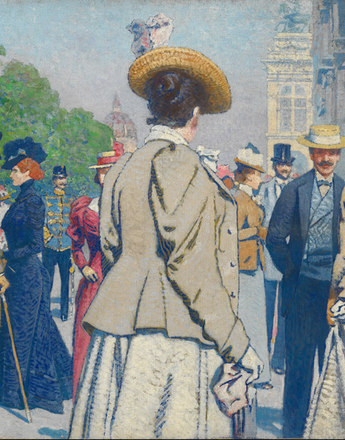From ‘view’ to narration: genres and stars
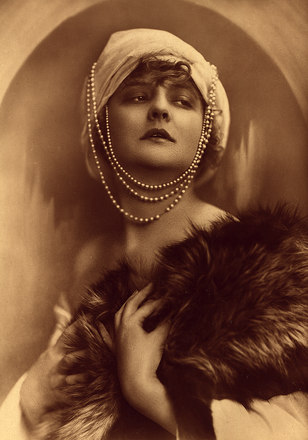
The film star Mia May, portrait photograph
Copyright: Filmarchiv Austria
Partner: Filmarchiv Austria
-
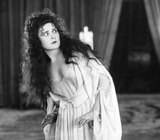
The film star Liane Haid, photograph
Copyright: Filmarchiv Austria
Partner: Filmarchiv Austria -

Advertisement in the magazine Der Kinematograph for the Asta Nielsen film “The girl without a fatherland”, 1912
Copyright: Filmarchiv Austria
Partner: Filmarchiv Austria -
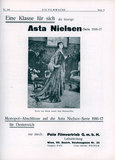
Advertisement in the magazine Die Filmwoche for Asta Nielsen film productions of 1916/17
Copyright: Filmarchiv Austria
Partner: Filmarchiv Austria -
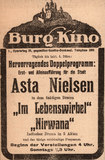
Advertisment for the Asta Nielsen Film “Im Lebenswirbel”, 1918
Copyright: Filmarchiv Austria
Partner: Filmarchiv Austria -
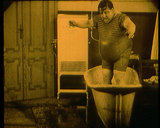
Der Bauernschreck, film still, A 1913
Copyright: Filmarchiv Austria
Partner: Filmarchiv Austria
The American film historian Tom Gunning coined the phrase ‘cinema of attractions’ to describe the early film presentations. Instead of narrating, as was to be customary later, the films simply put their subjects on show.
In the early days of cinema, the recordings (‘views’ or ‘vues’) did not have a cohesive narrative component and merely contained unconnected episodes. The camera showed, observed and examined what it saw without a clear interpretation or meaning. The ‘cinema of attractions’ also lacked figures with a psychological motivation or individual personality. In any case, the films were too short to permit such character development. There was just a brief situation, often with comical content, with the immediate effect being paramount. As editing and cutting techniques had not yet been developed and there were often no title cards, there was no creative design or dramatization of the material. The attraction lay in the sequence of pictures and accompanying attractions (music, artists, narrators, etc.).
The films gradually became longer. In 1907 the average length was 6 minutes, but by 1909 many films already ran for over 20 minutes. At the same time, there was a larger number of fictional films – two thirds of the productions in 1906. Major producers no longer presented ‘pictures’ but made dramas, comedies and tragedies and based their output on classic categories. By 1910 the two-hour feature film had arrived. New narrative strategies based on classical three- and five-act dramas were developed. More complex plots with familiar actors and actresses became commonplace. The film The Abyss in early 1911 with Asta Nielsen was acclaimed by critics and audiences alike. The actress was systematically promoted, and the premieres of each of her films were hyped as media events.
Austria-Hungary also had its first film stars. Mia May, wife of the Austrian director Joe May, was one of the first divas of German cinema. Liane Haid made her debut in the war propaganda film Mit Herz und Hand fürs Vaterland (A 1915) and became one of the greatest Austrian stars of the silent film era. She continued her career in the talking film era as well. Among the male stars there was Rudolf Walter and Josef Holub, who appeared in the 1910s and 1920s as the legendary Austrian double act Cocl & Seff. Their comedies were amongst the bestsellers of the time. In their first film together, Der Bauernschreck (A 1913), they played two social outsiders. Wrapped in a stolen bearskin, they terrify the inhabitants of a village and are paid a handsome reward for ‘vanquishing the beast’.
Translation: Nick Somers
Gunning, Tom: Vor dem Dokumentarfilm. Frühe non-fiction-Filme und die Ästhetik der „Ansicht“, in: KINtop 4, Anfänge des dokumentarischen Films, Jahrbuch zur Erforschung des frühen Films, Basel/Frankfurt am Main 1995, 111-121
Krenn, Günter/Wostry, Nikolaus (Hrsg.): Cocl & Seff. Die österreichischen Serienkomiker der Stummfilmzeit, Wien 2010
Müller, Corinna: Variationen des Filmprogramms. Filmform und Filmgeschichte, in: Müller, Corinna/Segeberg, Harro (Hrsg.): Die Modellierung des Kinofilms. Zur Geschichte des Kinoprogramms zwischen Kurzfilm und Langfilm (1905/6–1918), München 1998, 43-75
-
Chapters
- Projection shows – precursors of the cinema
- The first cinematograph in Vienna – a medium takes Austria-Hungary by storm
- From travelling show to cinema
- Roll up! Performances, attractions, shows and sound experiences
- ‘Numbers’ – jewels from all over the world
- From ‘view’ to narration: genres and stars
- Austrian film pioneers

